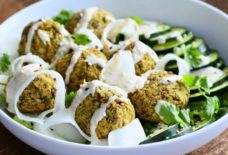Mediterranean Cooking from the Garden with Linda Dalal Sawaya—malfouf mihshi lamb and rice rolled in napa cabbage
lamb and rice stuffed cabbage rolls (malfouf mihshi bi lahme ou riz) © linda dalal sawaya 2015
Stuffing vegetables such as kousa, eggplants, tomatoes, peppers, and leaves such as grape, fig, cabbage, and chard is a time-honored tradition in the Mediterranean region. The Italians, Spanish, Greeks, Arabs, North Africans, and Eastern Europeans all do it in a variety of wasy. Varying mixtures of rice, onions, parsley, and mint with spices are typical as are meat and rice with spice fillings. Sometimes tomato sauces are the regional favorite, while other methods are preferred elsewhere. The convenience of this one-pot meal that combines seasonal ingredients makes this a universal form of preparing food that delights us.
My true preference is for the vegetarian rolls, but on special occasions, lamb and rice stuffed rolls that my mother and sitto made are in order.
Mihshi (or mahshi) means “stuffed” in Arabic, and malfouf means cabbage, so malfouf mihshi means simply “stuffed cabbage”.
The lemony flavor and delicate texture of malfouf mihshi more than compensate for the pungent aroma of cabbage filling the kitchen as it cooks. Cabbage leaves of any type can be wilted by steaming in hot water, and removing each leaf from the head of cabbage that’s had the central core removed with a knife. Last week, I used savoy cabbage for the vegan traditional rolls, which are referred to as siyeme, meaning Lenten; this week I’m using napa cabbage that came from a local organic farm to make lamb and rice filled rolls.
My beloved mama used to cut an entire leg of lamb for various Lebanese dishes, and freeze each type of cut for specific ones like: kibbe, mihshi, stews, laham mishwe, and so on. In those days of the 1950s even in Los Angeles, ground lamb was not available in supermarketsl In the Lebanese village, the butcher would prepare meat cuts to order for whatever you wanted to make. Nowadays, we can find ground lamb, but today’s American butchers don’t know about lamb they way mama explained it to me, nor do they know the ways of the village butcher.
According to my mother, Alice, there are certain types of fat on lamb that need to be removed otherwise there’s an unpleasant flavor associated with lamb that most Americans know of and dislike. The differences in the fat that is good, and that which needs to be removed is described in Alice’s Kitchen, in case you want to prepare the meat yourself. I have never seen in any other Leanese cookbook, five pages devoted to teaching about how to properly cut the leg of lamb for each Lebanese dish. The supermarket ground lamb that I find lately seems very fatty, most likely using the “bad” fat, and not lean enough, I purchased a lamb leg steak which I prepared removing the “bad” fat, keeping the “good” fat, and mincing it for our mishi. It did not take long to do it, and the results were far better than purchasing pre-packaged ground lamb. If all that is available is pre-packaged ground lamb, I add extra cinnamon and allspice to enhance and counter whatever strong flavors may want to emerge.
The wilted cabbage leaves are put into a colander to cool and drain, while the lamb and rice stuffing is prepared. Our stuffing is spiced with cinnamon, allspice, cayenne and black pepper, salt, and lemon juice.
lamb and rice stuffing for cabbage rolls © linda dalal sawaya 2015
Each leaf has the rib removed and placed on the bottom of the cooking pot as a cushion for the rolls so they don’t stick to the pot, along with lamb bones you may have. The rolls are individually stuffed and tightly rolled, placed into the pot stacked in layers perpendicular to each other, with fresh garlic cloves tucked between them.
lamb and rice on napa cabbage leaf © linda dalal sawaya 2015
Water, lemon juice, olive oil and seasonings are added to the pot, with a plate placed on top of the rolls to hold them together during the first half of stove-top simmering. The pot lid is also used to maintain heat and moisture.
layering cabbage rolls in the pot with fresh garlic and black peppercorns; then covered with a heavy plate © linda dalal sawaya 2015
When the rice is done, any extra liquid is poured off the pot and saved for soup stock. A large platter is placed on top of the pot and the pot carefully flipped upside down onto a platter for serving.
The lamb and rice malfouf may be served with a dollop of laban (yogurt), a lovely complement to the spiciness of the lamb and rice mixture.
lamb and rice stuffed cabbage rolls (malfouf mihshi bi lahme ou riz) ready to eat © linda dalal sawaya 2015
If you are a carnivore, these stuffed rolls make a lovely addition to your holiday table using seasonal ingredients made with love! They can be served warm or at room temperature. Sahtein and happy cooking!
—Linda Dalal Sawaya is a Portland artist, cook, Master Gardener, daughter of Lebanese immigrants, and author of Alice’s Kitchen: Traditional Lebanese Cooking
Remember, as my mother Alice said, “If you make it with love, it will be delicious!”
story and all photos © linda dalal sawaya 2015


